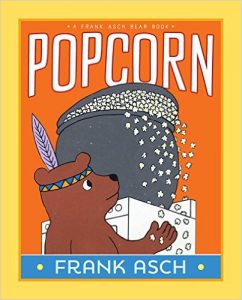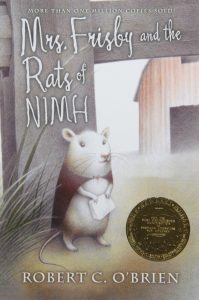
One wonderful aspect of being a parent is having the chance to revisit favorite childhood books. With Halloween around the corner, I dove back into Popcorn, a picture book by Frank Asch. In the story, Sam the bear’s parents go out to a Halloween party, leaving Sam home alone. So Sam decides to throw his own Halloween party. One by one friends show up in delightful costumes—bear as witch, bear as astronaut, bear as cowboy, and so on—each “bear”-ing a snack to share. And what do they all bring? Popcorn!
They pour every last kernel into a giant kettle. The popped corn spills out of the pot, fills the kitchen, pours out into the living room, pushes up the stairs, and pops out of the chimney. Inside it is dark. Bears cry out “What happened? Who turned out the lights?” They want to go home, but Sam orders them to eat. And eat they do, until every last kernel is gone. The scene with queasy looking Sam sweeping up the final kernels while friends lay on the ground, holding their stomachs or passed out in a food coma, parallels the aftereffects of elicit teenage house parties, something I didn’t notice as a kid.*
And that’s one great thing about re-reading: seeing what you missed the first time around.
The deeper book I actually wanted to talk about is a Newberry Medal winner by Robert C. O’Brien: Mrs. Frisby and the Rats of NIMH. Have you read it?
This is a chapter book (233 pages). The story is too complex to do it justice here, but to set the stage: Mrs. Frisby is a field mouse widow who lives on a farm. Her late husband was an exceptionally bright mouse who taught her to read, and so, in between fetching provisions for her children, Mrs. Frisby is teaching them letters. The seasons are changing, which means it is time for Mrs. Frisby to relocate her family out of their winter home in the vegetable garden to their summer home in the woods before the farmer plows the field. The problem is that one of her children, Timothy, is ill with pneumonia and cannot safely make the move.

To get Timothy help, Mrs. Frisby connects with a humorous crow, a wise owl, and, ultimately, “the rats of NIMH.” It turns out that the rats had known her husband; he had been part of an experiment with them at the mysterious NIMH. Scientists were using them to test if certain injections could make them learn faster and smarter. Ah ha! That’s how her husband learned to read.
My memories of the book from childhood mostly involved the characters and setting: the brave Mrs. Frisby, poor little Timothy, the gluttonous and villainous cat, and most of all those brilliant rats and the world they created. They had electricity, running water, job hierarchies, an economy, and a system of governance. Before cracking into the book again I could still conjure up an image of their intricate home underground, complete with elevators, a door bell, an electric fan ventilation system, and a massive and organized stash of food. I hadn’t really remembered the book’s lessons.
You see, after escaping from NIMH, the rats took up residence for the winter in a grand estate whose owners were away on a trip around the world. The pantry full of provisions was a draw, but it was the knowledge in the study that the rats hungered for most of all. They read encyclopedias, history books, science texts, poetry, and plenty of philosophy. They study the rise and fall of ancient civilizations, with a strong focus on the collapse. All this learning allows the rats to develop elaborate theories of the world and ultimately envision a utopian society.
Some of the messages seem a tad heavy handed now, but still ring true. One bit that stuck out to me on this most recent re-read was when one-eyed Nicodemus, one of the rat leaders, recounts being drawn to a chapter of a book called “The Rat Race,” because he was so eager to learn more about rats:
“It was about a woman in a small town who bought a vacuum cleaner. Her name was Mrs. Jones, and up until then she, like all of her neighbors, had kept her house spotlessly clean by using a broom and a mop. But the vacuum cleaner did it faster and better, and soon Mrs. Jones was the envy of all the other housewives in town—so they bought vacuum cleaners, too.
The vacuum cleaner business was so brisk, in fact, that the company that made them opened a branch factory in town. The factory used a lot of electricity, of course, and so did the women with their vacuum cleaners, so the local electric power company had to put up a big new plant to keep them all running. In its furnaces the power plant burned coal, and out of its chimneys black smoke poured day and night, blanketing the town with soot and making all the floors dirtier than ever. Still, by working twice as hard and twice as long the women of the town were able to keep their floors almost as clean as they had been before Mrs. Jones ever bought a vacuum cleaner in the first place.”
Nicodemus indignantly opines that the chapter should have been called “The Human Race” rather than “The Rat Race.”
That leads into the explanation of the big debate in the rat world: whether to continue to live comfortably, tapping humans’ water, electricity, and food in their pursuit of higher standards of living, or to relocate their civilization to Thorn Valley and become self-sufficient.
Some rats worry that living the high life with all the trappings would destroy their sense of purpose and lead to societal downfall. In Thorn Valley they would work hard, creating their own farms (they designed and built their own rat-sized plow to test the concept), but it would be honest work instead of thievery. They also would reduce their risk of discovery, since NIMH was still on the lookout to retrieve their research investment.
Other rats are loathe to give up their luxuries, feeling that they deserve to live in the comfortable world they engineered. They dismiss concerns about over-population and resource scarcity, assuming that their ingenuity will keep them prosperous.
These themes are large ones for children’s literature, but perhaps not surprising given that the author was also an editor at National Geographic. The book was published in 1971, three years after the Summer of Love and the publication of Paul Ehrlich’s The Population Bomb, and one year after the first Earth Day.
Did the rats decide to keep “keeping up with the Joneses”? Or do they start anew with a simpler existence? Does Mrs. Frisby move her home in time? And does Timothy get well? You’ll have to check out the book to find out.
* In case you were worried about Sam the bear, he gets the popcorn cleaned up and even makes it to bed before his parents come home. They wake him up (which no parent did ever) to surprise him with a special treat they brought home from the party: a bag of popcorn!

Awesome post! I look forward to introducing both of these books to R. The rats of NIMH was one of my favorite books.